Week 1: August 1-7, 2007
|
|
| THIS WEEK | THIS FALL | 2007 TOTAL | SITE TOTAL | |
|---|---|---|---|---|
| # birds (and species) banded | 210 (29) | 210 (29) | 994 (67) | 10312 (98) |
| # birds (and species) repeat | 31 (12) | 31 (12) | 146 (26) | 1695 (55) |
| # birds (and species) return | 10 (6) | 10 (6) | 95 (22) | 295 (28) |
| # species observed | 65 | 65 | 137 | 186 |
| # net hours | 370 | 370 | 2869.75 | 16892.5 |
| # birds banded / 100 net hours | 56 | 56 | 34.5 | 61 |
Note: table does not include nocturnal banding (owls)
Banders-in-charge:Marie-Anne Hudson Assistants: Sophie Cauchon, Jean Demers, Gay Gruner, Francine Marcoux, Sarah Marteinson, Chris Murphy, André Pelletier, Greg Rand, Clémence Soulard, Rodger Titman
Notes: MBO’s second full fall season got off to a surprisingly busy start on Wednesday, with 51 birds banded, one third of a full week’s worth from last fall! The pace didn’t quite keep up, and with one day almost totally rained out thanks to an explosive thunderstorm and several others ridiculously humid and hot, we closed out the week with 210 new birds banded. Of course when a new season is started everything seems new, but we’ve set a few new records for the site and for 2007 this past week, in addition to beginning our fall list anew: two new species banded for 2007 (Northern Cardinal and Scarlet Tanager) and two new species observed for 2007 (American Kestrel and Sora).
All of “our” birds are special to us, but two birds are especially worth mentioning this week. We recapped one of the young Eastern Kingbirds we banded in late June while still in the nest, indicating that the young hang around the nest site for over one month (we fully suspected this because kingbirds are anything but quiet!). We also recapped a very shabby-looking Veery undergoing a complete head-to-tail moult, and when we checked our records, we discovered that we had banded it as a juvenile in July 2005, which meant that it likely returned to its natal area to breed. These two birds perfectly illustrate some of the patterns and information we can deduce from banding – and we hope to recap them again next year!
We banded 58 more birds this week than at this time last year. The top spot definitely belongs to the Song Sparrow, which are absolutely everywhere, including our J-Trap. In fact, this was the only species the J-trap caught! We’re still hoping the blackbird flocks will come down, enticed by the seed we put out, but we’re not holding our breath. Most of the entries in the top ten are new since we did not get to do much banding in July, and none are more surprising than the Rose-breasted Grosbeak in fourth place. Had the weekly totals been calculated yesterday, the results would have been very different since we banded eight grosbeaks today! Most of the birds banded to date are young ones either hatched here or beginning their southward trek from nearby breeding grounds (Nashville Warblers breed further north, for example), and the grosbeaks are no exception. Interestingly, the top three spots are the same as last year.
| # individuals banded | mean # individuals observed daily |
|---|---|
| 1. Song Sparrow (57) [2] | Red-winged Blackbird (71) [1] |
| Yellow Warbler (27) [-] | Song Sparrow (25) [2] |
| Baltimore Oriole (17) [-] | American Goldfinch (23) [3] |
| Rose-breasted Grosbeak (14) [-] | Common Grackle (19) [-] |
| House Wren (11) [-] | Black-capped Chickadee (16) [4] |
| Swamp Sparrow (10) [-] | Cedar Waxwing (14)[9] |
| American Redstart (9) [-] | American Crow (13) [5] |
| Black-capped Chickadee (7) [-] | American Robin (11) [10] |
| Nashville Warbler (7)[-] | Yellow Warbler (8) [8] |
| Cedar Waxwing (6) [3] Common Yellowthroat (6) [-] | Baltimore Oriole (8) [-] |
The ten species most frequently observed this week are very similar to those from July, and from the first week of last year. Red-winged Blackbirds continue to dominate and are beginning to form rather large flocks, as are the Common Grackles. Song Sparrows and Black-capped Chickadees sing and twitter from virtually every grass hummock and shrub, while the Yellow Warblers skulk around in the hawthorns, no longer singing.
The high number of birds banded this week might reflect the fact that we’ve replaced several old nets with wonderfully dark new ones! Many thanks to the generous “net adopters” who have helped us cover the cost of these new nets. Please keep your eyes peeled for the net signs that will be erected shortly with the nets’ new names, as specified by the donors. We’d also like to thank Dave Bird for the fantastic push mower he donated to MBO. We’ve been having a blast running around trimming our net lanes and paths down so they’re nice and neat, and the site has never looked better!
One last item of note: we returned to Le Nichoir again this week to band a few youngsters (35 to be exact) almost ready to head out on their own. Among them, a sweet little Chimney Swift that clung to our shirts, a Yellow-bellied Sapsucker that knew exactly when to peck, and a whole whack of extremely intelligent Blue Jays very capable of evading our nets. We wish them the best of luck and thank Le Nichoir for taking such good care of them – they were all in great shape!
|
|
Week 2: August 8-14, 2007
|
|
| THIS WEEK | THIS FALL | 2007 TOTAL | SITE TOTAL | |
|---|---|---|---|---|
| # birds (and species) banded | 142 (33) | 352 (36) | 1136 (70) | 10454 (101) |
| # birds (and species) repeat | 50 (14) | 81 (19) | 196 (29) | 1745 (56) |
| # birds (and species) return | 6 (5) | 16 (7) | 101 (23) | 301 (28) |
| # species observed | 73 | 84 | 142 | 187 |
| # net hours | 462 | 832 | 3331.75 | 17354.5 |
| # birds banded / 100 net hours |
31 |
42 |
34.0 |
60.2 |
Note: table does not include nocturnal banding (owls)
Banders-in-charge: Marie-Anne Hudson, Barbara Frei Assistants: Sophie Cauchon, Shawn Craik, Jean Demers, Emily Gray, Gay Gruner, Francine Marcoux, Sarah Marteinson, Chris Murphy, André Pelletier, Greg Rand, Daniel Schmucker, Clémence Soulard, Rodger Titman
Notes: This week certainly started off with a bang – not in terms of the numbers of birds banded, but certainly in terms of the species. Within the first round on Wednesday, two new species were banded for the first time at MBO since its inception in 2004: a hatch-year Wood Thrush and a very pale hatch-year Marsh Wren, pictured above. To make matters even more exciting, a third species was added the very next day! A young male Cooper’s Hawk was found floundering in net D2, next to a Baltimore Oriole that looked none too pleased. Happily, both birds were perfectly fine and, once banded, measured and photographed, were raring to go.
Other new species banded this week were: Yellow-shafted Flicker (netted again later in the week), Philadelphia Vireo, Tennessee Warbler, Least Flycatcher, and Canada Warbler. Not to be outdone by the new species banded, we also observed tons of new species for this season: Great Horned Owl, American Bittern, Least Sandpiper, Northern Goshawk, Yellow-rumped Warbler, Hermit Thrush, Herring Gull, Red-shouldered Hawk, Lincoln’s Sparrow, Common Loon, Great Blue Heron, Ring-billed Gull (finally!), Rock Pigeon, and House Sparrow. A few of these were particularly noteworthy. The Hermit Thrush was exceptionally early, with the first individual in 2005 not seen until September 25, and in 2006 until September 30; likewise the Lincoln’s Sparrow is a record early arrival, with the previous record being August 30 in 2006. We’re hoping these birds aren’t an advance warning of an early winter! Also worth special mention is the Least Sandpiper, never before seen at MBO, becoming species #187 on our ever-growing checklist. These exceptional birds made for welcome excitement during an otherwise slow week – last year during week 2 we banded 225 birds.
This week’s top ten species banded is quite different from last week’s top ten. Five species have been added, and some are quite unusual for MBO: Traill’s Flycatchers and American Redstarts aren’t usually anywhere near the top of our weekly lists. This is likely due to both an influx of migrants and young dispersing from their natal site. The latter is especially true for Gray Catbirds and Downy Woodpeckers, as almost all have been hatch-year birds, some even juveniles. Imagine Barbara’s surprise when she arrived at C2 to find five extremely vocal Downy Woodpeckers all together, eager to escape and peck. Song Sparrows, though less than half than last week’s number (and barely one quarter as many as during this week last year), continued to dominate this week. As always, August is full of surprises, which makes it ever-interesting to compare this week to last year at this time: Baltimore Orioles, quite scarce at the moment, were in second position behind the Song Sparrow, and just ahead of the Rose-breasted Grosbeak. It just goes to show how different things can be from year to year – and why it is important to have several years of standardized data collection before assessing population trends.
| # individuals banded | mean # individuals observed daily |
|---|---|
| 1. Song Sparrow (20) [1] | 1. American Crow (26) [7] |
| 2. American Redstart (15) [7] | 2. American Goldfinch (23) [3] |
| 3. Traill’s Flycatcher (10) [-] | 3. Cedar Waxwing (18) [6] |
| Downy Woodpecker (9) [-] | Song Sparrow (18) [2] |
| 5. Yellow Warbler (9) [2] | 5. American Robin (15) [8] |
| 6. Red-eyed Vireo (8) [-] | 6. Black-capped Chickadee (15) [5] |
| 7. Black-capped Chickadee (7) [8] | 7. Common Grackle (14) [4] |
| 8. Gray Catbird (7) [-] | 8. Red-winged Blackbird (11) [1] |
| 9. Cedar Waxwing (5) [10] | 9. Ring-billed Gull (7) [-] |
| 10. Common Yellowthroat (5) [10] 10. Nashville Warbler (5) [9] | 10. Gray Catbird (6) [-] |
This week’s top ten species observed is similar to last week’s, with a few changes, as usual – nothing ever stays the same! Funnily enough, Ring-billed Gulls first appeared on the first day of the week, and quickly increased in number to appear on the top ten, albeit in 9th place. Red-winged Blackbirds, topping the list last week and in second position last year at this time, are way down the list in 8th place. We’re just waiting for the immense clouds of blackbirds (mainly Common Grackles and Red-winged Blackbirds) to reappear, as they did last year. We’re also waiting for the warblers to descend upon us, which should be any day now if these little guys are the front-runners…
|
|
Week 3 : August 15-21, 2007
Note: table does not include nocturnal banding (owls) Banders-in-charge: Marie-Anne Hudson, Barbara Frei Assistants: Jean Beaudreault, Sophie Cauchon, Shawn Craik, Jean Demers, Emily Gray, Gay Gruner, Geneviève Lussier, Sarah Marteinson, Chris Murphy, Jen Pearson, André Pelletier, Julie Pépin, Greg Rand, Clémence Soulard, Rodger Titman Notes: Well, if the first week of the fall season began with a bang, this week began with a whisper. The number of birds gracing us with their presence dropped off significantly, giving us time to do some much-needed site maintenance. Despite the lack of birds in the nets, though, we were quite happy to see many species for the first time this fall – and in a couple of cases the first time ever! The following species were newly banded this fall: Swainson’s Thrush, Eastern Phoebe, Great-crested Flycatcher, Brown Thrasher, and Mourning Warbler. We won’t list the new species observed for fall because there were 15, making for a very long list indeed. Two species we must highlight though are Common Moorhen and Clay-colored Sparrow, bringing the list of birds seen at MBO up to 189 species! Any predictions as to what number 190 will be? Despite the much lower number of birds banded, there were 11 more species observed this week than last week, and five more than at this time last year. But while the species count was impressive, most were present in small numbers – and even those tended to show little interest in visiting our nets this week. In fact, further proof of it being a quiet week is that just four individuals banded were enough to make the top ten list! This week’s top ten species banded is – surprise, surprise — quite different from last week’s top ten. Four species have been added, but to have the American Redstart at the top is unheard of at MBO. Rose-breasted Grosbeak is back on the list again, and Mourning Warblers have made their appearance, a bit of an anomaly for a relatively uncommon species. We were also surprised to see Swainson’s Thrush eke its way on to the bottom of the list this week. Strangely enough, the number of Song Sparrows has plummeted, and we can’t figure out why. We’ll keep our eyes and ears open and will get back to you with possible answers… hopefully! Common Yellowthroats have ‘tchacked’ their way up to third place. Baltimore Orioles are all but gone, as opposed to last year when they were in second place. We’re hoping that the Magnolia Warbler rush will begin soon, as it did last year at this time.
This week’s top ten species observed is similar to last week’s, and remarkably different from last year’s at this time. The Bobolinks that we were expecting (since they made the top ten last year at this time) haven’t arrived – likely due to the field being planted in alfalfa this year rather then left fallow (with leftover corn from the year before). A surprising inclusion on the list is Tree Swallow, seen streaming over the site early in the week, along with Barn Swallows, Purple Martins and the occasional Northern Rough-winged Swallow. The only constants are the gang of American Crows flying back and forth from the Arboretum to the trees lining the fields to the east, and the ever-present American Goldfinches zipping around feeding their young.
Week 4: August 22-28, 2007
Note: table does not include nocturnal banding (owls) Banders-in-charge: Marie-Anne Hudson, Barbara Frei, Marcel Gahbauer Assistants: Jean Demers, Gay Gruner, Barbara MacDuff, Francine Marcoux, Sarah Marteinson, Chris Murphy, Katleen Robert, Clémence Soulard, Rodger Titman Notes: This week welcomed Marcel Gahbauer temporarily back to the fold, as he ran the station Wednesday and Thursday and led the second MBO workshop on ageing and sexing of passerines (and near-passerines). We feel the workshop was a great success, and we hope everyone learned a lot and had a great time in the process! The week started off quite slowly, as either the sun shone brightly or it rained – whatever the weather, the birds remained few. However, the birds smiled on us for Sunday’s in-the-field portion of the workshop, and we banded 65 birds of 19 different species, allowing us to show off the birds’ great variation in moult strategy, plumage colour, and general demeanor. We really had tremendous luck with the workshop, as those 65 individuals represented over half of the birds banded this week – as well as the highest single-day total to date this fall! On top of that, the 53 species observed that day also represented the highest daily total of the young fall 2007 season. Despite the rather quiet week we’ve still managed to add species to our list of birds banded and observed, with one especially exciting banding: a young Black-billed Cuckoo graced our nets at closing on Monday morning – the second one of its species ever banded at MBO! Other new species banded include: Black-throated Blue, Blackpoll, Wilson’s, Bay-breasted and Yellow-rumped Warblers, bringing our season total to 47. While that trails a bit behind the 54 banded by this point last fall, we are ahead of the pace with the number of species observed, with 106 as of the end of this week, compared to 101 at this point in 2006. New species observed this week were Double-crested Cormorant (the 100th species of the season), Solitary Sandpiper, Black-throated Green Warbler, Blackpoll Warbler, Northern Pintail, Belted Kingfisher, and of course the cuckoo. Though we haven’t managed to hit 190 species for the site, we hope it will come once migration kicks up into high gear for September and October. We also permitted ourselves a couple of non-MBO banding excursions: we went on one last field trip up to Le Nichoir to band this year’s batch of young crows, as we’ve done for the past two falls. It was a great experience and will hopefully allow them to keep track of the youngsters once they ‘fly the coop’. Thanks to Greg Rand for so expertly grabbing them up and making sure a particularly feisty one nicknamed ‘Satan’ didn’t live up to its namesake! Our other excursion took us to a home in the West Island where a nest of Carolina Wrens was about to fledge. With the permission of the Bird Banding Office, we banded the five youngsters. As far as we know these are the first Carolina Wrens to be banded in Quebec! We’re hoping to see them at feeders around town and perhaps next year if they come back to breed. Fingers crossed! This week’s top 10 species banded is chock full of warblers! The Magnolia Warbler rush that we hinted at last week began in earnest this Sunday, just in time for our workshop. The low pressure system that moved through the area late Saturday night is likely responsible for the very warblery day we had Sunday, enabling the warblers to take over with seven out of the top 12 spots (thanks to a three-way tie for 10th place). Also traveling through the area were lots of Red-eyed Vireos and Least Flycatchers. All these warblers are getting us quite used to banding very small birds, which will serve us well when the waves of kinglets arrive a few weeks from now – though we will have to readjust when the American Robin movement begins in October!
American Crows continue to dominate the top 10 species observed this week, especially since over 200 of them were spotted sitting about the fields adjacent to MBO on Sunday. American Goldfinches and Black-capped Chickadees also again rounded out the top 10. Below the top three, however, changes were made! Cedar Waxwings, Song Sparrows and Common Grackles shuffled around slightly, but more interestingly, House Wrens, Red-eyed Vireos and American Redstarts made the list. For a warbler to make the top 10 observed species indicates just how many are in the area! We’ve been sure to take plenty of photos for our photo library, as American Redstarts can show quite a bit of variation when it comes to their plumage – both due to age and sex. The workshop participants now know that all too well, as many came through on Sunday and allowed themselves to be showcased to the group by workshop leader Marcel. Though they didn’t make the top 10, we were also excited about the reappearance of a few Bobolinks in the fields next to MBO. We’d been hearing their metallic little calls for the past few days but never spotted them until Sunday’s session – much to our relief as we were starting to doubt our hearing and/or sanity!
Week 5: August 29 – September 4, 2007
Note: table does not include nocturnal banding (owls) Banders-in-charge: Marie-Anne Hudson, Barbara Frei Assistants: Jean Beaudreault, Sophie Cauchon, Shawn Craik, Jean Demers, Emily Gray, Gay Gruner, Gillian Kinsman, Betsy Mcfarlane, Francine Marcoux, Sarah Marteinson, Chris Murphy, Dan Oyama, André Pelletier, Greg Rand, Katleen Robert, Helena Scheffer, Clémence Soulard Notes: The first week or so of September has traditionally been a somewhat slow period at MBO, and this year was no exception, though the number of birds banded this week was actually slightly higher than week 4 (and a considerable improvement over this year’s awfully slow week 3, when only 91 individuals were banded). But while the nets remained fairly quiet, another five species were observed for the first time this fall: Blue-headed Vireo, Cape May Warbler, Northern Parula, American Pipit and Yellow-bellied Flycatcher – most of which had been first recorded quite a bit earlier in the season last year. Four out of these five were actually banded – can you guess which one wasn’t? (Hint: it was seen flying over the fields calling ‘pipit, pipit, pipit’). An additional four new species were banded, bringing our season total to 56, just two behind last year at this time. Other weekly highlights include a first-time recap of the Black-billed Cuckoo banded on Monday, and three species that were banded for the first time this year: Sharp-shinned Hawk, Philadelphia Vireo, and Yellow-bellied Flycatcher. Although the nets were relatively quiet, we know from past experience that activity will soon pick up significantly. So, we took advantage of the relative lull to create some new paths through the increasingly snarled vegetation around Stoneycroft Pond. We can now view a good part of the pond from a little lookout cut out by the D nets. The raccoon tracks in the mud indicate that it’s quite the meeting spot! Another mammal-y highlight has been the Coyotes serenading us with their yips and yowls early in the morning, both from the fields just east of MBO, and from the field to the south of us by the Ecomuseum. Perhaps they’ve made friends with the two young wolves kept there? This week’s top 10 is almost identical to last week’s, with the Magnolia Warbler still leading the pack. This group of species was seen in good numbers at this time last year as well, showing remarkable consistency between years. Though the Blackpoll Warbler is far down the list with just four individuals banded, we wonder whether more are coming considering the number we banded last Spring. For more details regarding the Blackpoll explosion of spring 2007, please check out the season’s end report.
The list of top 10 species observed follows the top 10 banded list, in that there’s very little change from last week. One thing that the table doesn’t show is the number of low-flying raptors in the area. Sharp-shinned and Cooper’s Hawks, among others, have been milling about the site, though seldom getting caught. This marks the beginning of what we hope will be a great season for raptor watching!
Week 6: September 5-11, 2007
Note: table does not include nocturnal banding (owls) Banders-in-charge: Marie-Anne Hudson, Barbara Frei Assistants: Veronik Campbell, Sophie Cauchon, Shawn Craik, Jean Demers, Emilie Dion, Bob Edwards, David Fishman, Gay Gruner, Dimitris Kobiliris, Helen Leroux, Barbara MacDuff, Betsy Macfarlane, Sophie Mazowita, Chris Murphy, André Pelletier, Greg Rand, Emilie Roy-Dufresne, Clémence Soulard, Rodger Titman, Rea Trenchard Notes: Things are picking up a little! While still trailing last year’s totals by quite a bit, the birds are definitely starting to fly south, with clusters of White-throated Sparrows, Nashville and Magnolia Warblers zipping around our bushes and shrubs. Evidence to this effect: this week we observed and banded our first Ruby-crowned Kinglets and Slate-coloured Juncos for the season – the kinglets right on schedule compared to last year, but the junco a full three weeks earlier than in 2006. Other new observed/banded species for this week include Merlin (observed) and Brown Creeper (banded). Eclipsing all our new entries for the season though, is the exciting banding of a young male Golden-winged Warbler! We first observed a male Golden-winged during our initial season in fall 2004, high up in the canopy along the census trail, but haven’t even observed another since, so to be able to band one was quite unexpected! Needless to say we were quite excited about it. It’s funny how one season sets you up with expectations for the current season. Last year we were absolutely inundated with Common Grackles at this point. So, naturally, we’ve been waiting with bated breath for the clouds of grackles to descend upon us…. to no avail. We’ve not seen nearly as many grackles this week as last year at this time. Whether this is another sign that migration is delayed this year, or whether they’re congregating somewhere else, we don’t know. We’re hoping that they’ll still drop by because despite their rather aggressive nature in the nets, we still love them! The top 10 species banded this week has changed significantly since last week, with Magnolia Warbler tumbling from top spot to near the bottom, and half the list comprised of species that didn’t make it on at all in week 5. White-throated Sparrows now dominate the list, followed closely by the American Goldfinch. It’s not that we’ve been banding tons of goldfinches all week long – 18 of them arrived all at once in H1 during the closing round on Tuesday, making for a bird-filled net (see below). Luckily we had our camera handy! Now is still the ‘time of the warbler’ though, with half of the top 10 of the warblery persuasion, and the shrubs around the site (when not being blown around by gale-force winds) usually dripping with warblers if you watch closely enough. Of note, we’ve banded almost as many Wilson’s Warblers in the past two weeks as we did during the entire fall season last year. We’re hoping for overcast skies and no wind for next week, so that we can band as many of the warblers as possible while they’re still around.
The top 10 observed list is again topped by our usual four suspects. The changes come in further down the list, with Canada Goose, White-throated Sparrow, and yes, even the European Starling making their first appearances of the season. Those of you familiar with the avifauna of our site should be somewhat surprised with the starling’s appearing on the list (even in 10th position), as we only rarely see them at MBO. Truth be told, they appeared only twice last week, but in sufficient number to warrant including them in the table. The same is true of the Canada Goose, though we know their numbers will swell as the fall progresses. Likewise, white-throats are steadily increasing in number and are sure to be included in the top 10 lists for weeks to come. On the other hand, the Song Sparrow is getting scarcer by the week, though past seasons suggest that at least some will stick around MBO until close to the end of the fall season.
Week 7: September 12-18, 2007
Note: table does not include nocturnal banding (owls) Banders-in-charge: Marie-Anne Hudson, Barbara Frei Assistants: Jean Beaudreault, Veronik Campbell, Sophie Cauchon, Shawn Craik, Diane Demers, Jean Demers, Lacey Hébert, Gay Gruner, Helen Leroux, Alessia Kockel, Barbara MacDuff, Francine Marcoux, Eve Marshall, Mike Mayerhofer, Heather Milligan, André Pelletier, Greg Rand, Katleen Robert, Clémence Soulard, Rodger Titman, Shona Watt Notes: With an influx of migrants late in the week, the number of birds staging at MBO went up considerably. Unfortunately with the sun shining brightly, these same birds didn’t always end up in our nets, opting to spend their time kicking up the fallen leaves under the hawthorns (White-throated Sparrows), gleaning insects off the leaves still attached to the taller trees around the property (warblers) or flying high around the site in small groups (Common Grackles). Even in our seventh week we managed to band some new species of warbler: our first Orange-crowned and Western Palm Warblers of the year, as well as our first Black-throated Green Warbler, which had been hanging out near the nets for several days before actually being caught. We hope the others will follow its example! Other species banded this week for the first time this fall were Winter Wren, Chipping and Savannah Sparrow. New species observed this week include Broad-winged Hawk and a single Spotted Sandpiper. We keep saying how similar some years can be, but when we looked at last year’s week 7 report, we nearly fell off our chairs: Winter Wren, Savannah Sparrow, Orange-Crowned Warbler, Yellow Palm Warbler (pretty close to a Western…) were all banded for the first time last season during week 7 as well. Raptor migration is definitely underway, with several kettles of Broad-winged Hawks swirling over MBO this past week. Add to that the several low-flying Sharp-shinned (of which two were banded!), Cooper’s, Red-shouldered and Red-tailed Hawks, as well as the occasional Northern Harrier and Merlin, and we consider our raptor diversity to be quite good … though we’re still looking forward to the Turkey Vulture and Osprey flights of last year. Toss in an eagle or two and we’ll be thrilled! The top 10 species banded this week has almost flipped itself on its head compared to last week. White-throated Sparrows are still holding their own, well in the lead at number one, but the rest of the top five were last week’s bottom five! It’s easy to move around the table when the number of birds banded is so low – we’re hoping migration will peak soon so we can have those hundred bird days that keep us moving the entire morning. If you’re dying to see some “confusing fall warblers”, it’s not too late: half of our top ten is still composed of warblers. The vireo wave has apparently passed, with the Red-eyed Vireo not even appearing on the list after being in fourth position last week. If we look at last year’s report at this time, there’s one glaring difference (and a direct contradiction to our statement at the end of the first paragraph): the number of Yellow-rumped Warblers is basically nil right now, when they were the most abundant species banded by far last year. An excellent illustration of the sporadic, wave-like and sometimes completely unpredictable nature of migration! Of note, despite bird numbers remaining much lower than last year, diversity continues to be high, with two more species banded (and also two more observed) than at this point in fall 2006.
The top 10 observed list has been rearranged a little since last week, with the White-throated Sparrow leaping up from seventh to second position. The rest of the crew are pretty much the same, but have been shuffled around somewhat. For the first time this season (and as far as we can recall, ever), we now find a raptor in the top ten, with Broad-winged Hawks taking the last spot.
Week 8: September 19-25, 2007
Note: table does not include nocturnal banding (owls) Banders-in-charge: Marie-Anne Hudson, Barbara Frei Assistants: Nick Ackeson, Jean Beaudreault, Veronik Campbell, Sophie Cauchon, Natalia Castellanos, Han Chen, Shawn Craik, Diane Demers, Jean Demers, Emilie Dion, Dominique Fauteux, David Fishman, Linda Fishman, Val Francella, Jeff Harrison, Issac Hébert, Gay Gruner, Helen Leroux, Alex Liautaud, Alyssa Macleod, Mike Mayerhofer, Sophie Mazowita, Heather Milligan, André Pelletier, Greg Rand, Katleen Robert, Emilie Roy-Dufresne, Clémence Soulard, Rodger Titman, Shona Watt, Sarah Woods Notes: The past two days have made up for a pretty slow week, with 117 birds banded! It appears the birds have decided that they just can’t wait for those north winds anymore, and they’re moving despite the steady south or south-west winds that have been blowing for the past few days. Hopefully this will let us catch up to last year’s fall numbers over the next few weeks. Although once again the number of birds banded this week is lower than during the same period last year, the diversity of species is again higher, with 39 this year compared to 33 in 2006. Likewise the 82 species observed this week beat out last year’s 78, and the season-to-date totals in both categories remain well ahead of the pace from 2006. We managed to band a bunch of new species for the fall this week: Eastern White-crowned Sparrow and Golden-crowned Kinglet (these two both right on time, also banded for the first time during week 8 last year), Hermit Thrush, Grey-cheeked Thrush, and Blue Jay. Most of these were new species observed this fall as well, in addition to Rusty Blackbird, Turkey Vulture (FINALLY!), Osprey, Great Black-backed Gull, and Field Sparrow. The top 10 species banded has many new entries this week, despite the White-throated Sparrow maintaining a wide lead. American Goldfinch vaulted to second position after last week’s 8 th spot by landing about 4-6 at a time in the nets a few times this week. As predicted based on our few years of banding at MBO, the Ruby-crowned Kinglet is inching its way up the list, appearing in third place, and likely to peak over the next three weeks. The surprising entries though are the two races of Palm Warbler in sixth and ninth place – counted together they are the third most frequently banded species of the week. The sudden influx of Palms is reminiscent of the 33 that we banded during week 7 of the 2005 fall season, and both of these experiences are in stark contrast to 2006, when the entire fall season yielded only 9. On the other hand, last year we saw a remarkable spike in Yellow-rumped Warbler numbers, peaking with 163 banded in week 8 alone – and this year at the same time they haven’t even broken into the top ten for the week! As MBO’s history lengthens, it will be interesting to see whether there are consistent two-year cycles for species such as these.
The top 10 observed list has again been rearranged, with Canada Goose and Common Grackle replacing White-throats and Blue Jays in the top three – and in the process matching the top three for this week in 2006. The number of American Robins is definitely on the rise, hinting at big numbers for this October if the rains hold off. Our blackbird flocks have also returned – maybe they read our last weekly update asking them to come back? Let’s just hope they clue in on the fact that our J-trap is full of delicious seeds, just ready to be eaten (if the Chipmunks don’t get them all first that is). Though the top 10 tables don’t always reflect it, when you’re at MBO day after day, you tend to notice the waves of species moving through, whether it’s the Swamp Sparrows and Palm Warblers from Monday and Tuesday, or the White-throated Sparrows from well, every day. And these are just the birds hitting the nets. The skies are now full of Canada Geese, blackbirds and raptors, so there’s always something to look at – yes, even at noon when it’s 25 degrees out! On a closing note, we are thrilled to welcome the new group of Ornithology and Natural History of Vertebrates students, and look forward to their continued participation through the rest of this season and beyond!
Week 9: September 26 – October 2, 2007
|
||||||||||||||||||||||||||||||||||||||||||||||||||||||||||||||||||||||||||||||||||||||||||||||||||||||||||||||||||||||||||||||||||||||||||||||||||||||||||||||||||||||||||||||||||||||||||||||||||||||||||||||||||||||||||||||||||||||||||||||||||||||||||||||||||||||||||||||||||||||||||||||||||||||||||||||||||||||||||||||||||||||||||||||||||||||||||||||||||||||||||||||||||||||||||||||||||||||
Note: table does not include nocturnal banding (owls)
Banders-in-charge: Marie-Anne Hudson, Barbara Frei Assistants: Jean Beaudreault, Kristen Brochu, Veronik Campbell, Sophie Cauchon, Shawn Craik, Diane Demers, Jean Demers, Kait Farrell, Peter Hall, Jeff Harrison, Gay Gruner, Joelle Guillet, Helen Leroux, Alex Liautaud, Barbara MacDuff, Alyssa Macleod, Jennifer MacWilliam, Mike Mayerhofer, Sophie Mazowita, Annie-Claude Paradis, André Pelletier, Leigh Piercey-Brunet, Greg Rand, Katleen Robert, Marc-André Robert, Emilie Roy-Dufresne, Stephanie Steves, Anna Solecki, Krystal Swift, Rachel Theoret-Gosselin, Shona Watt
Notes: This week was our biggest week of the year so far, by over 100 birds! This increase is largely due to the 112-bird day on Friday, but overall there were noticeably more birds around this week despite some unseasonably warm temperatures (maybe the seasonably cool start to the week helped). Granted even this busy week involved over 200 fewer birds than the rush we faced at the same time last year, so the trend of a quieter-than-usual season continues. On the other hand, it’s getting more and more difficult to add new species to our seasonal lists since we’ve had a great season in terms of species diversity (if not individual abundance). This week, however, we were able to add Pine Warbler and American Tree Sparrow to our observed species list. We missed out on new species banded though, for the first time this season.
Though we’re still banding lots of warblers, a distinct shift in our bird-life has occurred, and is visible in the top 10 list of birds banded. The sparrows are taking over! Whether it’s White-throats (still leading the pack), White-crowned (vaulting up to third spot), Song or Swamp (both reappearing in large numbers after laying low for a while), or the more elusive Lincoln’s and Chipping Sparrows, the sparrows have a definite foothold at MBO. We’re also in the midst of a Black-capped Chickadee invasion, with increasing numbers of young birds being banded on a daily basis. Time will tell what this coming week will hold — perhaps more peck-happy friends? The northeastern population has shown a tendency to move south in much larger numbers in “odd” falls over the past decade or so, and we experienced a big movement in 2005, so this might be the start of something.
As was noted in last week’s report, the scarcity of Yellow-rumped Warblers this fall is very noticeable in comparison with 2006. In fact, comparing just this week, they alone account for almost the entire difference in bird volume between the two years: 236 banded in week 9 last year versus just 12 this year (in comparison, there were 309 birds of other species in 2006 and 298 in 2007). Also of note, Ruby-crowned Kinglets last year at this time were outnumbering White-throated Sparrows in the nets by a 2:1 ratio and this year that has been more or less reversed. However, the kinglets have in the past few years tended to peak around Thanksgiving, so the next week should give us a better sense of their numbers this year.
| # individuals banded | mean # individuals observed daily |
|---|---|
| 1. White-throated Sparrow (96)[1] | 1. Canada Goose (433) [2] |
| 2. Ruby-crowned Kinglet (45)[3] | 2. American Crow (106) [1] |
| 3. White-crowned Sparrow (22)[-] | 3. Red-winged Blackbird (75)[10] |
| Black-capped Chickadee (16)[7] | White-throated Sparrow (60)[4] |
| 5. American Goldfinch (15)[2] | 5. Common Grackle (56) [3] |
| 6. Song Sparrow (15) [4] | 6. American Robin (42) [5] |
| 7. Swamp Sparrow (13) [8] | 7. Blue Jay (28) [8] |
| 8. Yellow-rumped Warbler (12) [-] | 8. Black-capped Chickadee (22)[7] |
| 9. Blue-headed Vireo (8)[-] | 9. Ruby-crowned Kinglet (15)[-] |
| 10. American Robin (6) [-] 10. Western Palm Warbler (6) [7] 10. Slate-coloured Junco (6) [-] | 10. American Goldfinch (15)[9] |
The top 10 observed list is fairly similar to last week’s, with the blackbirds holding their own across the board, unlike last year, when both Common Grackles and Red-winged Blackbirds were very scarce during this period. The number of Canada Geese going over on a daily basis is always nice to see, their honking advertising their presence well before they come into view. If only all species were that cooperative with our observers! Blue Jay numbers this week are also noteworthy, with nearly 30 per day being well above normal numbers at MBO. Large flocks of them have also been seen streaming alone the northern shorelines of Lakes Ontario and Erie over the past week, reflecting an unusually significant flight for this irregular migrant.
|
|
Week 10: October 3-9, 2007
|
|
| THIS WEEK | THIS FALL | 2007 TOTAL | SITE TOTAL | |
|---|---|---|---|---|
| # birds (and species) banded | 486 (36) | 2005 (74) | 2789 (86) | 12107 (103) |
| # birds (and species) repeat | 69 (13) | 442 (43) | 557 (47) | 2106 (59) |
| # birds (and species) return | 1 (1) | 43 (12) | 128 (24) | 328 (29) |
| # species observed | 75 | 135 | 158 | 191 |
| # net hours | 399 | 4341 | 6840.8 | 20863.6 |
| # birds banded / 100 net hours | 121 | 46 | 41 | 58 |
Note: table does not include nocturnal banding (owls)
Banders-in-charge: Marie-Anne Hudson, Barbara Frei Assistants: Jean Beaudreault, Sophie Cauchon, Anne Chen, Shawn Craik, Diane Demers, Jean Demers, Diana Dima, Simon Duval, David Fishman, Jeff Harrison, Gay Gruner, Demetrios Kobiliris, Aless Kockel, Helen Leroux, Marie-Pierre Lambert, Alex Liautaud, Barbara MacDuff, Sarah Marteinson, Chris Murphy, Annie-Claude Paradis, André Pelletier, Leigh Piercey-Brunet, Greg Rand, Katleen Robert, Emilie Roy-Dufresne, Christina Saliba, Anna Solecki, Rea Trenchard, Sandra Warren
Notes: This week has shattered our previous ‘big week’ record for 2007 by about 150 birds, and has even surpassed this week’s total for last year (a first for this season). Not only were numbers up, but we also managed to band 13 more species than last year at this time, and 10 more species were observed. As the numbers indicate, we’ve had a pretty big week: our slowest day clocked in at 43 birds banded, and our biggest at 122! Needless to say we’re very thankful for our great volunteers who were fantastic net assistants, scribes and extractors – you made our jobs that much easier. Although the unseasonably warm weather for much of this fall has probably accounted for some of the lower numbers we’ve seen, at this point in the season it may actually explain the higher diversity in that some of the earlier migrants have lingered a bit later than they usually would.
New species observed this week include a special addition to the site list: White-winged Crossbill! We’ve been hoping for this species to make its way from the Arboretum to our site for 3 years, and it finally did. Thanks to Jeff for “gettin’ ‘em!” We’re all the more pleasantly surprised as it comes at a time when the White-winged Crossbill populations are peaking in western and eastern Canada, and relatively few appear to be left in Quebec and Ontario. The other new species for the season is the Fox Sparrow, which was also a newly banded species for this season (right on time), along with the Eastern Bluebird – another first for the site! Now that we’ve been in operation for a few years, it’s getting more and more difficult to get new species for the banded list, so we’re especially excited for the addition of the bluebird, which brings the count to 103.
As was suggested in last week’s report, Ruby-crowned Kinglets tend to peak around Thanksgiving, and sure enough, this week has been full of kinglets, with an almost 2:1 ratio of them compared to White-throated Sparrows. They vaulted to the top of the list this week, followed by the ever-increasing American Robin, already tied with the White-throated Sparrow. Also on the increase was the number of Black-capped Chickadees. This week has very much confirmed that we’re being invaded by northern chickadees that tend to be larger and stocked with fat reserves. The number of Yellow-rumped Warblers is up from last week, but still nowhere near last year’s numbers. Slipping a little from last week in the standings but still holding their own: White-crowned Sparrows, which really love the J-trap even when it’s not set, Song Sparrows, American Goldfinch and Swamp Sparrow round out the top ten.
| # individuals banded | mean # individuals observed daily |
|---|---|
| 1. Ruby-crowned Kinglet (98)[2] | 1. Canada Goose (901) [1] |
| 2. American Robin (54) [10] | 2. American Robin (116) [6] |
| 3. White-throated Sparrow (54)[1] | 3.American Crow (106) [2] |
| Black-capped Chickadee (52)[4] | White-throated Sparrow (38)[4] |
| 5. Yellow-rumped Warbler (46)[8] | 5. Red-winged Blackbird (37)[3] |
| 6. Slate-colored Junco (44)[10] | 6. European Starling (32)[-] |
| 7. White-crowned Sparrow (35)[3] | 7. Ruby-crowned Kinglet (30)[9] |
| 8. Song Sparrow (18) [6] | 8. Slate-colored Junco (29)[-] |
| 9. American Goldfinch (16)[5] | 9. Black-capped Chickadee (26)[8] |
| 10. Swamp Sparrow (10) [7] | 10. White-crowned Sparrow (20) [-] |
The top 10 observed list is fairly similar to last week’s, with the Canada Geese filling the sky, and more than twice as numerous as they were at this point last year. American Robin numbers are steadily increasing, and also slightly ahead of their 2006 numbers. They’re most vocal first thing in the morning, making the poplars over the B/N nets positively deafening. The juncos have finally made their appearance on the top 10 list after being on site for a few weeks now. The major influx came a few days ago, and they’ve been on the increase ever since.
Owling has been fairly successful thus far, with 5 owls banded over 3 nights total. We’re hoping for lots more over the next few nights, as steady northeast winds have been forecast. The biggest news so far is that the owling program also generated a new addition to the all-time checklist this week, in the form of a Barred Owl perched on the reliable old dead tree at the north end of Stoneycroft Pond. It became species #191 on the list, our eleventh addition this year (the others in chronological order being Ring-necked Duck, Vesper Sparrow, Sandhill Crane, Eastern Meadowlark, Eastern Towhee, and Greater Scaup in spring, followed by some new sightings this fall – Least Sandpiper, Common Moorhen, Clay-colored Sparrow, and this week’s White-winged Crossbill).
|
|
Week 11: October 10-16, 2007
|
|
| THIS WEEK | THIS FALL | 2007 TOTAL | SITE TOTAL | |
|---|---|---|---|---|
| # birds (and species) banded | 430 (27) | 2435 (75) | 3219 (86) | 12537 (103) |
| # birds (and species) repeat | 55 (12) | 497 (43) | 612 (47) | 2161 (59) |
| # birds (and species) return | 1 (1) | 44 (12) | 129 (24) | 329 (29) |
| # species observed | 55 | 135 | 158 | 191 |
| # net hours | 348.5 | 4689.5 | 7189.6 | 21212.1 |
| # birds banded / 100 net hours | 123.4 | 51.8 | 44.6 | 59.0 |
Note: table does not include nocturnal banding (owls)
Banders-in-charge: Marie-Anne Hudson, Barbara Frei Assistants: Jean Beaudreault, Kristen Brochu, Anne Chen, Shawn Craik, Diane Demers, Jean Demers, Ross Diamond, Diana Dima, Emilie Dion, Melanie Drouin, David Fishman, Jeff Harrison, Tiffany Gamelin, Gay Gruner, Joelle Guellet, Joelle Lapalme, Alyssa Macleod, Barbara MacDuff, Jennifer MacWilliam, Sarah Marteinson, Mike Mayerhofer, Sophie Mazowita, Chris Murphy, Annie-Claude Paradis, Leigh Piercey-Brunet, Greg Rand, Katleen Robert, Brittney Roughan, Brian Schmucker, Anna Solecki, Stephanie Steeves, Clémence Soulard, Rachel Theoret-Gosselin
Notes: This was another pretty big week, especially considering we lost net hours to bad weather. Variability in weather is a big reason for us calculating the “# birds banded per 100 net hours”, as this statistic allows for a more fair comparison between time periods (and locations). By this standard, week 11 was the busiest so far this fall, thanks in part to a 139-bird day on Wednesday (which equates to nearly 200 birds / 100 net hours for that morning). Thanks to all who volunteered during this busy week – for the first time in MBO’s history, every volunteer slot was filled for the entire week! New birds banded include American Tree Sparrow, which are now present in good number on-site. New birds observed… well, there weren’t any – so we remain stuck at 134, which is just one more than the total we had at this time last year; meanwhile the cumulative total for the year (159) is identical to this point in 2006, showing remarkable consistency. We’re hoping though that this coming week will bring some late season migrants in.
The Ruby-crowned Kinglet still reigns supreme with a large lead this week, maintaining its top spot on the top 10 banded list. American Robin follow in the second spot yet again, with an impressive 80 birds banded (which means some very heavy-looking nets filled with robins). Chickadees and juncos rose to third and fourth spot respectively, knocking the white-throats into fifth position. The amount of feeble white-throat singing first thing in the morning has definitely decreased as well, suggesting they’re well on their way. Hermit Thrush appeared at number six for the first time this season – and this doesn’t even reflect how many times we’ve recaptured each one. These guys are definitely anything but net shy. Their appearance is right on time, as we banded 14 of them at this time last year. The white-crowns are still holding steady at number seven, adding further to their record high season total (75 banded in the last three weeks alone, compared to a previous high of 50, set last fall). Song Sparrows also maintained their position in 8th place. The new entries reflect the shifting avian community, with our “winter sparrows”, the American Tree and Fox Sparrows, appearing in the last two slots of the list.
| # individuals banded | mean # individuals observed daily |
|---|---|
| 1. Ruby-crowned Kinglet (145)[1] | 1. Canada Goose (800) [1] |
| 2. American Robin (80) [2] | 2. American Robin (347) [2] |
| 3. Black-capped Chickadee (34)[4] | 3.Red-winged Blackbird (202)[5] |
| Slate-colored Junco (29)[6] | American Crow (110) [4] |
| 5. White-throated Sparrow (25)[3] | 5. European Starling (56)[6] |
| 6. Hermit Thrush (21) [-] | 6. Ruby-crowned Kinglet (38)[7] |
| 7. White-crowned Sparrow (18)[7] | 7. White-throated Sparrow (36)[4] |
| 8. Song Sparrow (17) [8] | 8. Slate-colored Junco (22)[8] |
| 9. American Tree Sparrow (10)[-] | 9. Common Grackle (20) [-] |
| 10. Fox Sparrow (10)[-] | 10. Black-capped Chickadee (18)[-] |
The top 10 observed list is fairly similar to last week’s, with Canada Geese and robins sharing the sky with Red-winged Blackbirds, American Trees and the occasional flock of European Starlings. Common Grackles and Black-capped Chickadees are winking in and out of the top 10 list on a weekly basis now, indicating their ever-present status on site, but occasionally being pushed out of the top 10 by more abundant species. Our waterfowl list is pretty sad this year, as the fields next to us are still green and corn-free. Who knows what the top ten list will look like next year at this time if they decide to plant corn… Perhaps we’ll again have an average of 27 Mallards a day as we did last year?
A little aside: Marie-Anne and Marcel were very pleased to be able to attend the biannual Canadian Migration Monitoring Meeting in Slave Lake, Alberta this past weekend. Our thanks to Environment Canada in Quebec for contributing some funds toward our travel costs. We were able to update everyone on MBO’s progress over the past two years (something we’re very proud of), trade ageing tips, discuss ongoing research efforts, and spend time with other banders, something we’re always excited to do. We left the meeting feeling energized and eager to try new things at MBO. Since we’re so late in the season, these changes will likely only be seen next spring, all the more reason for you to keep a few days set aside for us!
|
|
Week 12: October 17-23, 2007
|
|
|
|||||||||||||||||||||||||||||||||||
Note: table does not include nocturnal banding (owls)
Banders-in-charge: Marie-Anne Hudson, Barbara Frei Assistants: Jean Beaudreault, Kristen Brochu, Shawn Craik, Emilie Dion, Melanie Drouin, Dominique Fautaux, Isaac Hebert, Tiffany Gamelin, Gay Gruner, Marie-Melissa Kalamaras, Gillian Kinsman, Joelle Lapalme, Alex Liautaud, Barbara MacDuff, Jennifer MacWilliam, Francine Marcoux, Sarah Marteinson, Chris Murphy, Annie-Claude Paradis, André Pelletier, Greg Rand, Katleen Robert, Krystal Swift, Anna Solecki, Stephanie Steeves, Rachel Theoret-Gosselin, Rae Trenchard, Sandra Warren
Notes: Weather-wise this week contained a few days that could have been slotted into July and no one would have been the wiser. However, above-seasonal temperatures certainly didn’t deter our autumn migrants! The proof is in the number of American Robins bobbing about the site. Our highest daily total was 1150, making for some very noisy skies. Their orangey-red breasts are the perfect colour for the season, matching our fiery-leafed maples. The maples seem to be hanging on to their leaves a little longer than the Eastern Cottonwoods on site, which have lost the majority of their leaves over the past two days. No worries, there are still have a few days to check out the fall colours before the wind knocks them all down!
With one week left in the fall season, we still managed to get some new species. New species banded include two Northern Shrikes (the first time we’ve banded more than one in a season, let alone a single week!) and a Common Grackle (remarkable considering that last fall we banded 35 of them). New species observed include Pine Siskin and the aforementioned Northern Shrike. Though we’re still over 400 birds short of last year’s banding total at this time, we’re three species ahead in terms of species observed, and have also banded one more species. Just goes to show how variable seasons can be, and how much we’re at the mercy of the weather! Another reminder of how important it is to focus on long-term monitoring in order to separate year-to-year fluctuations influenced by local weather patterns from actual population trends that can be used to guide conservation strategies.
This week’s top ten banded list reflects the week’s slowed pace relative to last week. Ruby-crowned Kinglets still dominate despite being halved from last week. Other than the disappearance of the Hermit Thrush and White-crowned Sparrow from the list, enabling our little goldfinches and Golden-crowned Kinglets to pop on, the list remains quite similar to last week’s.
| # individuals banded | mean # individuals observed daily |
|---|---|
| 1. Ruby-crowned Kinglet (73)[1] | 1. Canada Goose (946) [1] |
| 2. American Robin (68) [2] | 2. American Robin (333) [2] |
| 3. Slate-colored Junco (38)[4] | 3.Red-winged Blackbird (220)[3] |
| Black-capped Chickadee (21)[3] | American Crow (179) [4] |
| White-throated Sparrow (21)[5] | 5. Common Grackle (108) [9] |
| 6. Song Sparrow (16) [8] | 6. European Starling (38)[5] |
| 6. American Tree Sparrow (16)[8] | 7. Slate-colored Junco (37)[8] |
| 8. Fox Sparrow (9) [10] | 8. Ruby-crowned Kinglet (20)[6] |
| 9. American Goldfinch (5)[-] | 9. White-throated Sparrow (17)[7] |
| 9. Golden-crowned Kinglet (5)[-] | 10. Black-capped Chickadee (15)[10] |
The top 10 observed list for this week has simply been picked up and shaken, causing the top and bottom to stay the same and the middle to shift around a bit. This line-up is similar to last year’s top 10 as well, though it lacks Cedar Waxwing (nomads that they are), Blue Jay, and Mallard. Who knows, with the way the Mallards are beginning to appear (54 today), they may yet end up on our top 10!
|
|
Week 13: October 24-30, 2007
|
|
|
|||||||||||||||||||||||||||||||||||
Note: table does not include nocturnal banding (owls)
Banders-in-charge: Marie-Anne Hudson, Barbara Frei Assistants: Jean Beaudreault, Brian Bell, Jose Bnchetrit, Kristen Brochu, Diane Demers, Ross Diamond, Emilie Dion, Diana Dima, Melanie Drouin, Dominique Fautaux, Tiffany Gamelin, Gay Gruner, Marie-Melissa Kalamaras, Gillian Kinsman, Marie-Pier Lampert, Steph Letendre, Alex Liautaud, Barbara MacDuff, Chris Murphy, Annie-Claude Paradis, Greg Rand, Katleen Robert, Emilie Roy-Dufresne, Christina Saliba, Anna Solecki, Rachel Theoret-Gosselin, Rae Trenchard
Notes: The end of the fall season came with a bit of a whimper, as two banding days were lost, and a few more hampered by high winds. The high-flyers that dominated the site at this time of year wouldn’t have ever gotten caught in the nets anyway, so we don’t think our numbers are terribly biased by the lack of banding. Last year the final week of the season showed a similar pattern of reduced net hours due to rain and wind and an even lower number of birds banded (94).
However, our census went on unabated, providing us with oodles of observations. We never could have even imagined the number of new species to visit us in this last week! New species observed include Cackling Goose, American Green-winged Teal, American Black Duck, Bohemian Waxwing, Pine Grosbeak, Evening Grosbeak, and Common Redpoll, bringing our total for the season to 144, a full ten species more than last fall.
The top 10 list of birds banded is a bit funny this week, since only a few of the species should be on the list. With six species tied for the last spot with two birds banded, a top six would be more appropriate this week. At least it gives a fair representation of the bird life on site – well, birds that are likely to be banded at any rate. We finally seemed to shake the October/bad weather curse and banded a good number of robins in our last week, bringing them to over 300 banded this October! The Black-capped Chickadee movement is still underway, keeping them high on the list (as opposed to last year when they weren’t even on it at all). The rest of our winter birds round out the table nicely, contrasting with the distinctly migratory set of birds from last year (Ruby-crowned Kinglet, Indigo Bunting, and Hermit Thrush).
| # individuals banded | mean # individuals observed daily |
|---|---|
| 1. American Robin (99) [2] | 1. Canada Goose (1670) [1] |
| 2. Black-capped Chickadee (15)[4] | 2. Red-winged Blackbird (700)[3] |
| 3. American Tree Sparrow (8)[7] | 3. American Robin (234) [2] |
| Fox Sparrow (5)[8] | American Crow (167) [4] |
| 5. Slate-colored Junco (4)[3] | 5. Mallard (139) [-] |
| 6.Song Sparrow (4) [6] | 6. Common Grackle (81) [5] |
| 7. European Starling (63)[6] | |
| 8. Black-capped Chickadee (16)[10] | |
| 9. American Goldfinch (13)[-] | |
| 10. Slate-colored Junco (10)[7] |
The top 10 birds observed are very similar to last week’s, with only two new entries: Mallard and American Goldfinch. We assume it’s because we lamented the lack of Mallards in last week’s update that they showed up in huge flocks numbering over 200! Throw in the handful of American Black Ducks hiding in amongst them and you’ve got some very happy observers. Overall, birds were much more abundant this week than at the same time last year – most notably, over 20 times more Canada Geese, 12 times as many Mallards, and 5 times more Red-winged Blackbirds, plus more modest increases for American Robin and American Crow.
Exciting news! We just got the word in that one of our little Yellow-rumped Warblers was recaptured in Chestertown, Maryland, 17 days after it was banded at MBO on September 30th, 2006. We suppose it took the banding office a little time to process the recapture since banding records are only submitted in their entirety at the end of each year. Better late than never! This bird now joins the ranks of the banded Slate-coloured Junco recaptured in New Jersey, and the handful of locals found around Ste-Anne’s and Senneville. We very much look forward to what spring will bring. Please stay tuned for the fall report, and watch the photo library as we process updates to our species accounts during the winter months. It was a pleasure to work with each and every one of you! Thank you so much for your support – it’s so very much appreciated!
|
|
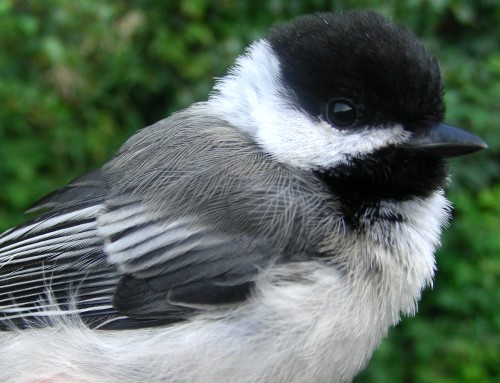 This baby-faced Black-capped Chickadee was one of many young birds banded this week at MBO. We find it almost impossible to photograph chickadees looking “proper” (and not in mid-peck), so we knew we had to share this one with you. (Photo by Marie-Anne Hudson)
This baby-faced Black-capped Chickadee was one of many young birds banded this week at MBO. We find it almost impossible to photograph chickadees looking “proper” (and not in mid-peck), so we knew we had to share this one with you. (Photo by Marie-Anne Hudson)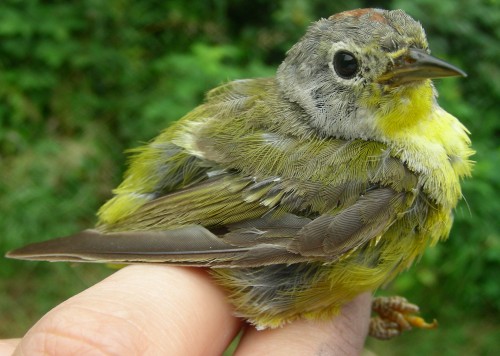 This after-hatch year male Nashville Warbler is busy moulting like crazy now that the breeding season is over and its time to think about migrating southward. At this time of year, most adults tend to look a little haggard compared with the nest-fresh young ones with their new feathers. (Photo by Marie-Anne Hudson)
This after-hatch year male Nashville Warbler is busy moulting like crazy now that the breeding season is over and its time to think about migrating southward. At this time of year, most adults tend to look a little haggard compared with the nest-fresh young ones with their new feathers. (Photo by Marie-Anne Hudson)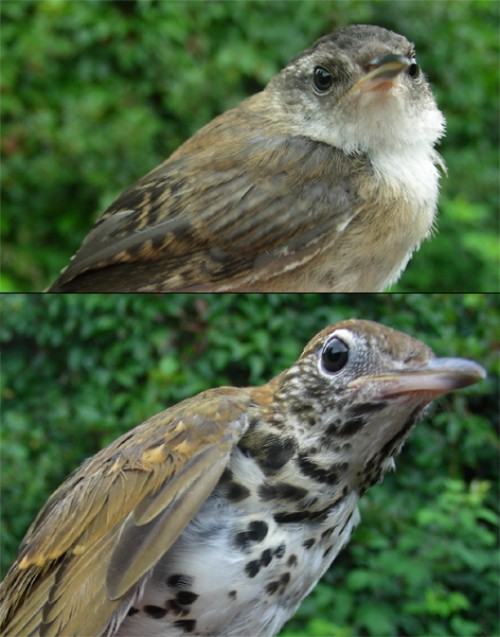 This week’s superstars: two out of the three new species banded this week for the first time at MBO. The third species had to unfortunately be omitted from this collage due to technological difficulties in extracting photos from a cell phone (note: always keep fresh AA batteries on site), and so might appear in next week’s update. Can you guess what they are? See the text below for the answer. (Photos by Marie-Anne Hudson)
This week’s superstars: two out of the three new species banded this week for the first time at MBO. The third species had to unfortunately be omitted from this collage due to technological difficulties in extracting photos from a cell phone (note: always keep fresh AA batteries on site), and so might appear in next week’s update. Can you guess what they are? See the text below for the answer. (Photos by Marie-Anne Hudson)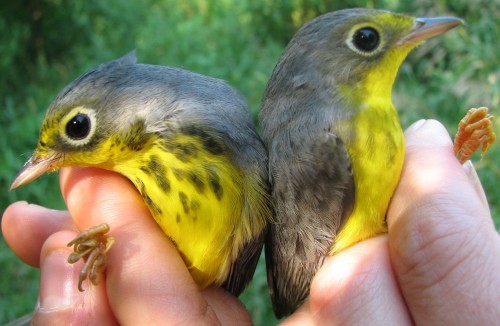 These two young Canada Warblers graced our nets at the same time, enabling us to get a great comparative shot of the two, the male on the left, the female on the right. (Photo by Barbara Frei)
These two young Canada Warblers graced our nets at the same time, enabling us to get a great comparative shot of the two, the male on the left, the female on the right. (Photo by Barbara Frei)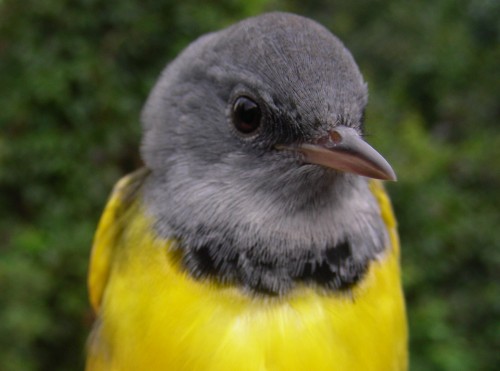 This beautiful after-hatch year male Mourning Warbler was one of five banded this week at MBO. The warblers are definitely on the move! (Photo by Marie-Anne Hudson)
This beautiful after-hatch year male Mourning Warbler was one of five banded this week at MBO. The warblers are definitely on the move! (Photo by Marie-Anne Hudson)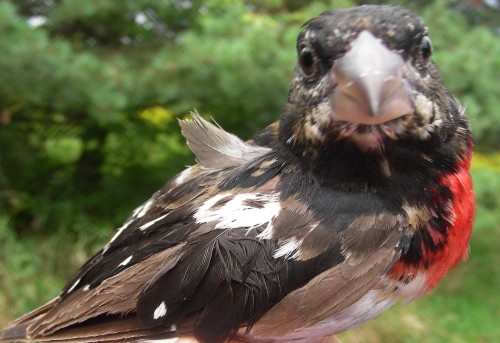 This second-year male Rose-breasted Grosbeak was netted this week, showing how scruffy young males can look. Normally second-year can’t be determined for passerines in fall (hatch-year or after-hatch-year being the only options in most cases), but this guy has clearly retained his juvenile brown plumage and is only now moulting into his spiffy adult plumage. (Photo by Marie-Anne Hudson)
This second-year male Rose-breasted Grosbeak was netted this week, showing how scruffy young males can look. Normally second-year can’t be determined for passerines in fall (hatch-year or after-hatch-year being the only options in most cases), but this guy has clearly retained his juvenile brown plumage and is only now moulting into his spiffy adult plumage. (Photo by Marie-Anne Hudson)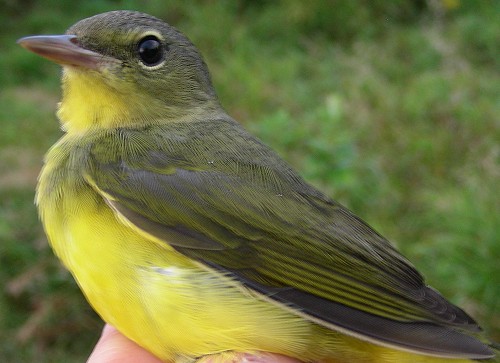 We couldn’t very well give the older male Mourning Warbler all the glory … this hatch-year male looks an awful lot like a Common Yellowthroat. The key: a greyer head and a broken eye-ring, plusyellow extending across the entire underparts (Photo by Marie-Anne Hudson)
We couldn’t very well give the older male Mourning Warbler all the glory … this hatch-year male looks an awful lot like a Common Yellowthroat. The key: a greyer head and a broken eye-ring, plusyellow extending across the entire underparts (Photo by Marie-Anne Hudson)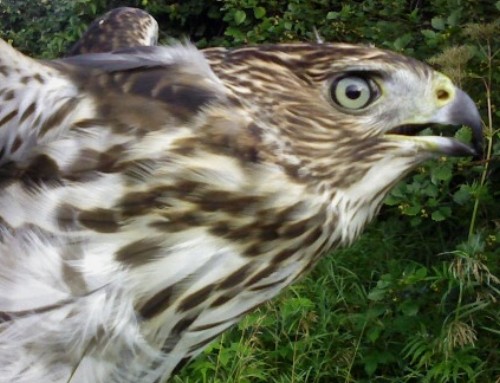 And finally, we figured out how to get photos off a cell phone! Here’s the young (hatch-year) male Cooper’s Hawk from last week – he was very well behaved. (Photo by Marie-Anne Hudson)
And finally, we figured out how to get photos off a cell phone! Here’s the young (hatch-year) male Cooper’s Hawk from last week – he was very well behaved. (Photo by Marie-Anne Hudson)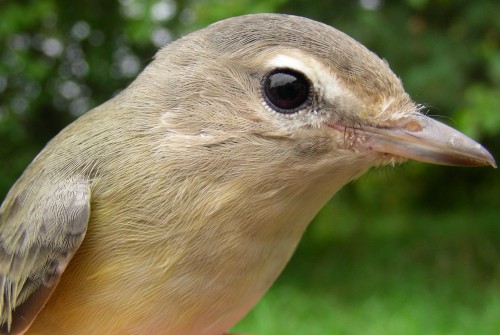 This tricky little Warbling Vireo had us puzzled for a while, as it sported a band that was was very close to one of our active strands but nowhere to be found in our logs. After a quick check in our records from last year, we found out that we banded it as a hatch-year bird almost exactly one year before (plus one day) This likely means that it returned to its natal site to breed – a very interesting discovery, and one of the many reasons banding is so neat! (Photo by Marcel Gahbauer)
This tricky little Warbling Vireo had us puzzled for a while, as it sported a band that was was very close to one of our active strands but nowhere to be found in our logs. After a quick check in our records from last year, we found out that we banded it as a hatch-year bird almost exactly one year before (plus one day) This likely means that it returned to its natal site to breed – a very interesting discovery, and one of the many reasons banding is so neat! (Photo by Marcel Gahbauer)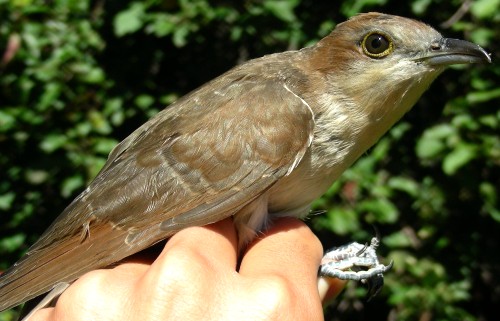 This hatch-year Black-billed Cuckoo was only the second one of its kind to be banded at MBO, and as the last bird of the day on a rather slow day this week, was quite welcomed indeed! You never know what’s going to show up, no matter how quiet the birds are… (Photo by Marcel Gahbauer)
This hatch-year Black-billed Cuckoo was only the second one of its kind to be banded at MBO, and as the last bird of the day on a rather slow day this week, was quite welcomed indeed! You never know what’s going to show up, no matter how quiet the birds are… (Photo by Marcel Gahbauer)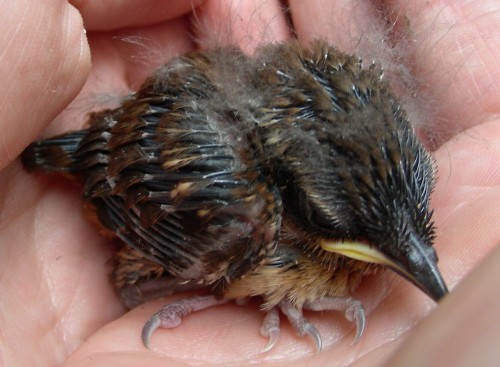 Though quite young, this Carolina Wren’s legs are the size of an adult’s, allowing us to band it before it leaves the nest. Our observer at the nest assures us that everyone behaved quite normally after being banded and all fledged quite happily! We’re hoping they’ll return to breed next year. (Photo by Sarah Marteinson)
Though quite young, this Carolina Wren’s legs are the size of an adult’s, allowing us to band it before it leaves the nest. Our observer at the nest assures us that everyone behaved quite normally after being banded and all fledged quite happily! We’re hoping they’ll return to breed next year. (Photo by Sarah Marteinson)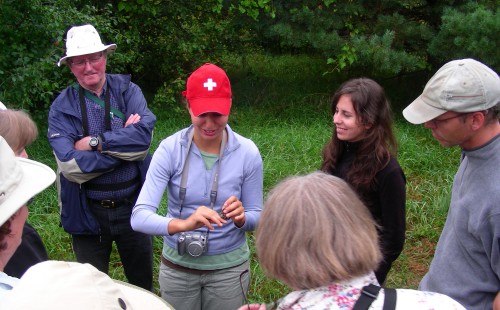 We always knew Barbara would draw in a crowd… throw in a young House Wren and they’re irresistible! This photo was taken during the in-the-field portion of MBO’s second Ageing and Sexing Workshop given last weekend to a group of about 15 eager learners. (Photo by Marcel Gahbauer)
We always knew Barbara would draw in a crowd… throw in a young House Wren and they’re irresistible! This photo was taken during the in-the-field portion of MBO’s second Ageing and Sexing Workshop given last weekend to a group of about 15 eager learners. (Photo by Marcel Gahbauer) It’s amazing how similar two species can appear until you have them side by side. On the right, a Warbling Vireo and on the left, a Philadelphia Vireo. (Photo by Marie-Anne Hudson)
It’s amazing how similar two species can appear until you have them side by side. On the right, a Warbling Vireo and on the left, a Philadelphia Vireo. (Photo by Marie-Anne Hudson)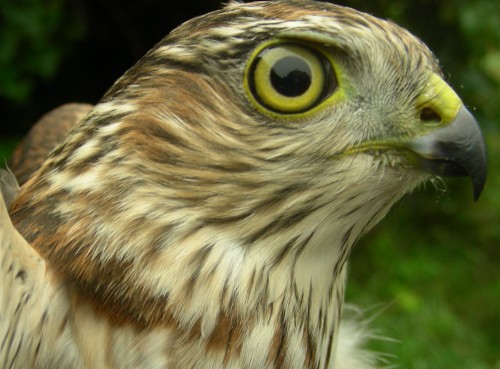 This young Sharp-shinned Hawk almost felt like a robin when we extracted it from the net, but with a smaller head. They’re deceptively large in flight, but small in the hand! (Photo by Marie-Anne Hudson)
This young Sharp-shinned Hawk almost felt like a robin when we extracted it from the net, but with a smaller head. They’re deceptively large in flight, but small in the hand! (Photo by Marie-Anne Hudson)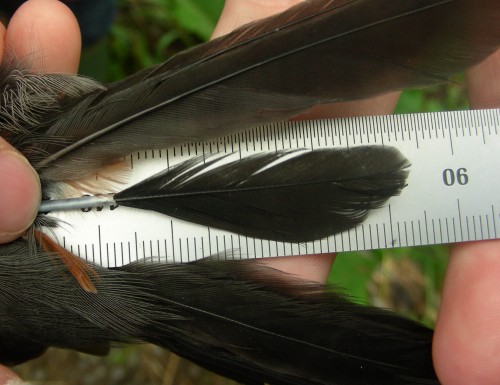 Last spring and this fall, we’ve been collecting 2 tail feathers from a short list of target species being studied by the Canadian Migration Monitoring Network, for a collaborative study using stable isotope analysis. We’ve been asked how long it takes for the birds to grow their feathers back. Well, this hatch-year Gray Catbird was plucked on August 4th, and this photo was taken on the 31st. The feathers have grown back to almost full length in just 27 days. (Photo by Marie-Anne Hudson)
Last spring and this fall, we’ve been collecting 2 tail feathers from a short list of target species being studied by the Canadian Migration Monitoring Network, for a collaborative study using stable isotope analysis. We’ve been asked how long it takes for the birds to grow their feathers back. Well, this hatch-year Gray Catbird was plucked on August 4th, and this photo was taken on the 31st. The feathers have grown back to almost full length in just 27 days. (Photo by Marie-Anne Hudson)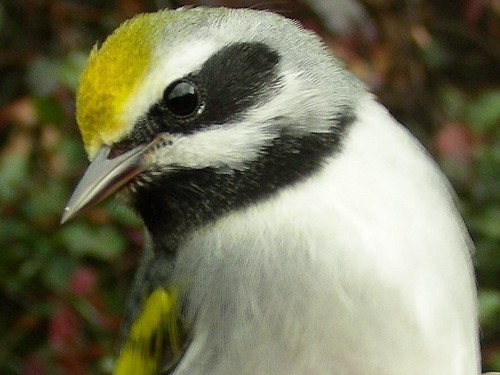 We thought about kidding around and posting an American Goldfinch or a Black-capped Chickadee photo in this most coveted spot (not that they’re not photogenic, but we net them on a daily basis), but this hatch-year male Golden-winged Warbler clearly warranted being the photo of the week. (Photo by Marie-Anne Hudson)
We thought about kidding around and posting an American Goldfinch or a Black-capped Chickadee photo in this most coveted spot (not that they’re not photogenic, but we net them on a daily basis), but this hatch-year male Golden-winged Warbler clearly warranted being the photo of the week. (Photo by Marie-Anne Hudson)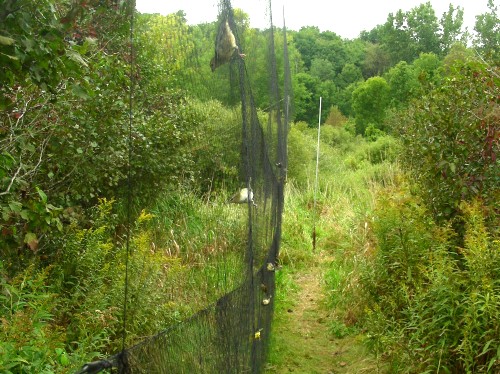 We really had trouble choosing the “star” photos for this week, since there were so many highlights! As migration really gears up, our nets will look like this more and more, and we’re sure pictorial highlights will become harder and harder to choose between. (Photo by Marie-Anne Hudson)
We really had trouble choosing the “star” photos for this week, since there were so many highlights! As migration really gears up, our nets will look like this more and more, and we’re sure pictorial highlights will become harder and harder to choose between. (Photo by Marie-Anne Hudson)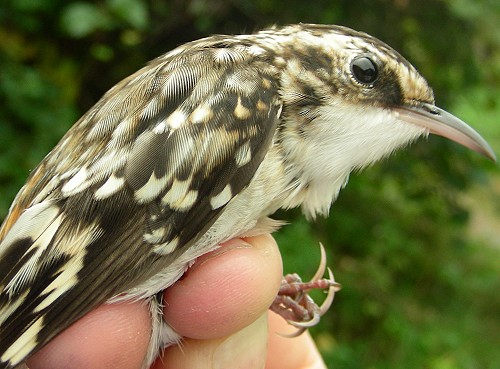 We found this little Brown Creeper in our nets at closing on Tuesday. There’s still so little known about creepers and their moult chronology, so it’s a good thing we were able to age it without problem by looking at the degree of ossification of the skull. (Photo by Marie-Anne Hudson)
We found this little Brown Creeper in our nets at closing on Tuesday. There’s still so little known about creepers and their moult chronology, so it’s a good thing we were able to age it without problem by looking at the degree of ossification of the skull. (Photo by Marie-Anne Hudson)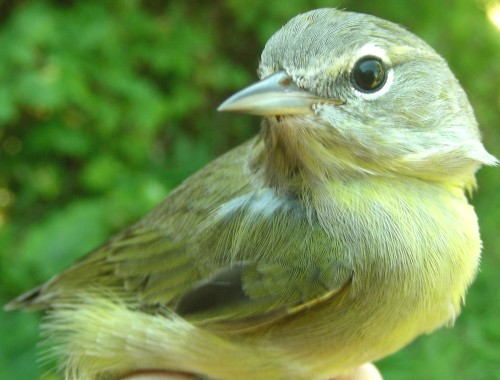 Another week, another uncommon warbler! We banded this hatch-year male Orange-crowned Warbler after carefully ensuring that it wasn’t a Tennessee. You can see why we’d be thorough and take a look at the crown (orangey) and the undertail coverts (bright yellow), which confirm the identification. (Photo by Marie-Anne Hudson)
Another week, another uncommon warbler! We banded this hatch-year male Orange-crowned Warbler after carefully ensuring that it wasn’t a Tennessee. You can see why we’d be thorough and take a look at the crown (orangey) and the undertail coverts (bright yellow), which confirm the identification. (Photo by Marie-Anne Hudson)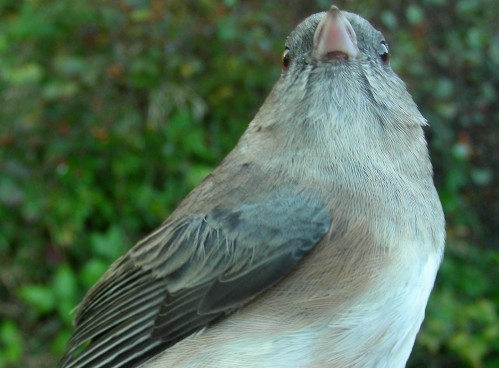 No, this hatch-year female Slate-coloured Junco isn’t looking down her “nose” at you, but rather curiously checking out the camera lens from a different angle. Juncos are starting to put in regular appearances in both the nets and observations, signaling that winter is surely on its way (in a while, don’t worry!) (Photo by Marie-Anne Hudson)
No, this hatch-year female Slate-coloured Junco isn’t looking down her “nose” at you, but rather curiously checking out the camera lens from a different angle. Juncos are starting to put in regular appearances in both the nets and observations, signaling that winter is surely on its way (in a while, don’t worry!) (Photo by Marie-Anne Hudson)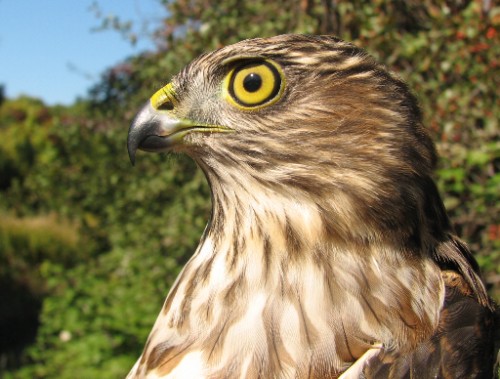 We finally moved beyond 1000 birds for the season this week, with this very photogenic hatch-year female Sharp-shinned Hawk. (Photo by Barbara Frei)
We finally moved beyond 1000 birds for the season this week, with this very photogenic hatch-year female Sharp-shinned Hawk. (Photo by Barbara Frei)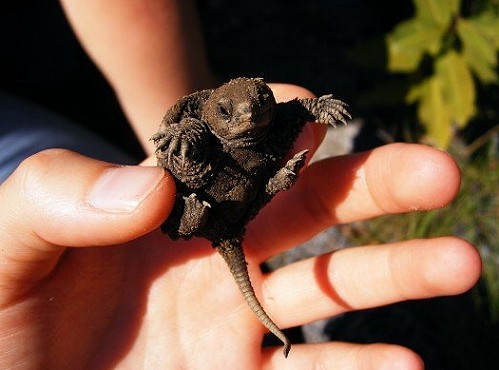 We were *this* close to having a non-avian photo as our highlight of the week, but the 1000th bird of the season just couldn’t be ignored. The 30 young snapping turtles that hatched on Thursday are instead highlighted here, but were no less exciting. (Photo by Shona Watt)
We were *this* close to having a non-avian photo as our highlight of the week, but the 1000th bird of the season just couldn’t be ignored. The 30 young snapping turtles that hatched on Thursday are instead highlighted here, but were no less exciting. (Photo by Shona Watt)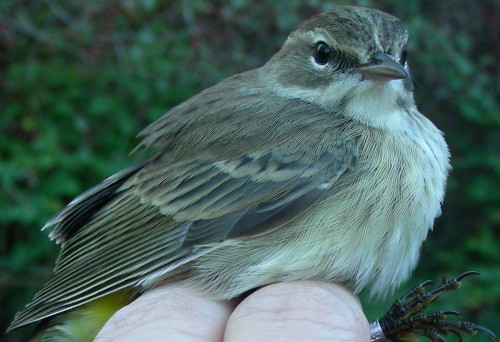 This young Western Palm Warbler was one of 16 Palm Warblers banded this week, the biggest movement we’ve seen of this species since mid-September 2005. (Photo by Marie-Anne Hudson) .
This young Western Palm Warbler was one of 16 Palm Warblers banded this week, the biggest movement we’ve seen of this species since mid-September 2005. (Photo by Marie-Anne Hudson) .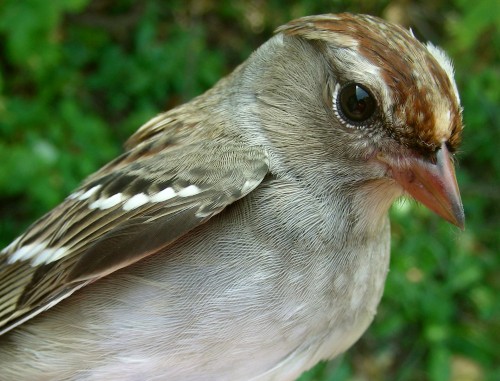 The wave of Eastern White-crowned Sparrows moving through this week made for some easy banding: ageing is done in mere seconds by looking at the head, since hatch-year birds have tan/brown crowns and adults have the regular white/black crown. If only all birds were this easy! (Photo by Marie-Anne Hudson)
The wave of Eastern White-crowned Sparrows moving through this week made for some easy banding: ageing is done in mere seconds by looking at the head, since hatch-year birds have tan/brown crowns and adults have the regular white/black crown. If only all birds were this easy! (Photo by Marie-Anne Hudson)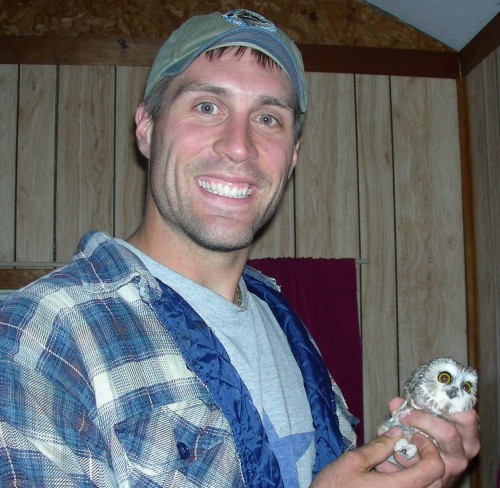 Exciting news on the owl front! Our first effort since October 2005 netted us a third-year Northern Saw-whet Owl on Sunday night. We’ve heard from other observatories that this is a great year for owl banding, so our resident owl-man Shawn Craik decided to give our owl program a try. Fingers are crossed that this little guy/girl is one of many! (Photo by Marie-Anne Hudson)
Exciting news on the owl front! Our first effort since October 2005 netted us a third-year Northern Saw-whet Owl on Sunday night. We’ve heard from other observatories that this is a great year for owl banding, so our resident owl-man Shawn Craik decided to give our owl program a try. Fingers are crossed that this little guy/girl is one of many! (Photo by Marie-Anne Hudson)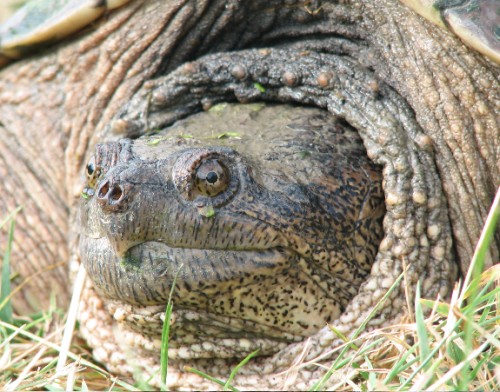 Where there are babies, there’s usually a momma lurking somewhere nearby. Barbara reported that this huge Snapping Turtle was very well behaved and amazingly nimble. (Photo by Barbara Frei)
Where there are babies, there’s usually a momma lurking somewhere nearby. Barbara reported that this huge Snapping Turtle was very well behaved and amazingly nimble. (Photo by Barbara Frei)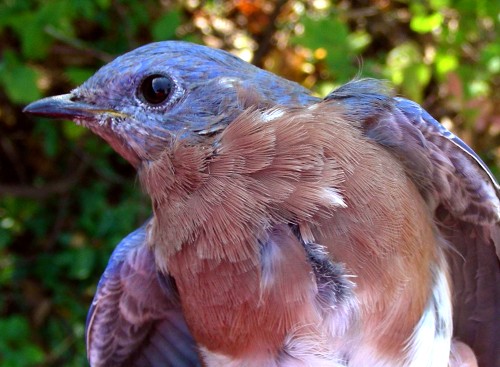 We couldn’t believe our eyes when we found two of these special hatch-year birds in our nets. A gang of Eastern Bluebirds has been hanging around all week, but we never expected them to come down to net level, as they’ve teased us like this every fall so far, but without ever getting caught. (Photo by Marie-Anne Hudson)
We couldn’t believe our eyes when we found two of these special hatch-year birds in our nets. A gang of Eastern Bluebirds has been hanging around all week, but we never expected them to come down to net level, as they’ve teased us like this every fall so far, but without ever getting caught. (Photo by Marie-Anne Hudson)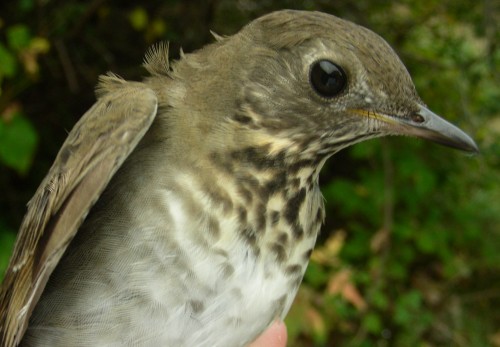 A very interesting discussion on Bird Protection Quebec’s SongSparrow e-mail group highlighted the importance of careful and detailed observation when it comes to differentiating between Gray-cheeked and Bicknell’s Thrushes. Luckily with this one in hand, we were able to take the wing measurements that help differentiate between the two, making this one a bonafide Gray-cheeked. (Photo by Marie-Anne Hudson)
A very interesting discussion on Bird Protection Quebec’s SongSparrow e-mail group highlighted the importance of careful and detailed observation when it comes to differentiating between Gray-cheeked and Bicknell’s Thrushes. Luckily with this one in hand, we were able to take the wing measurements that help differentiate between the two, making this one a bonafide Gray-cheeked. (Photo by Marie-Anne Hudson)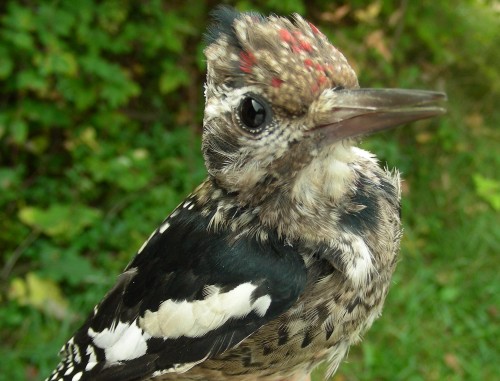 This young Yellow-bellied Sapsucker was quite eager to peck our fingers (and the camera) during this photo session, but thankfully our experience with woodpeckers has taught us how to avoid the worst of it. (Photo by Marie-Anne Hudson)
This young Yellow-bellied Sapsucker was quite eager to peck our fingers (and the camera) during this photo session, but thankfully our experience with woodpeckers has taught us how to avoid the worst of it. (Photo by Marie-Anne Hudson)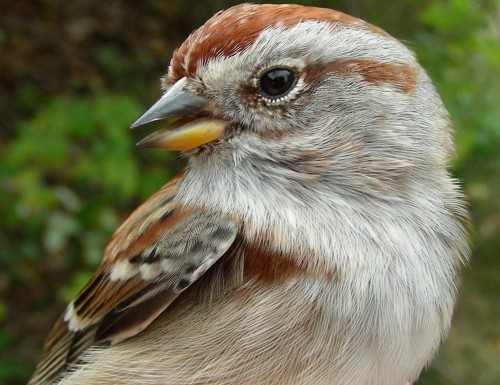 The arrival of American Tree Sparrows in spades this week signals that winter is certainly on its way! This little hatch-year was kind enough to pose for a quick photo session before release (Photo by Marie-Anne Hudson)
The arrival of American Tree Sparrows in spades this week signals that winter is certainly on its way! This little hatch-year was kind enough to pose for a quick photo session before release (Photo by Marie-Anne Hudson)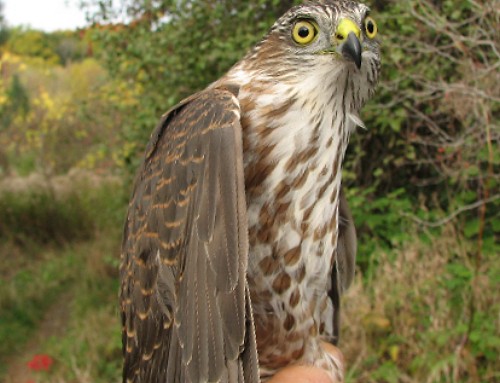 We know we’ve already put up hawk photos, but we don’t get that many so we thought we could get away with another one *grin*. After all, this hatch-year was so photogenic, albeit a little awkward looking. (Photo by Barbara Frei)
We know we’ve already put up hawk photos, but we don’t get that many so we thought we could get away with another one *grin*. After all, this hatch-year was so photogenic, albeit a little awkward looking. (Photo by Barbara Frei)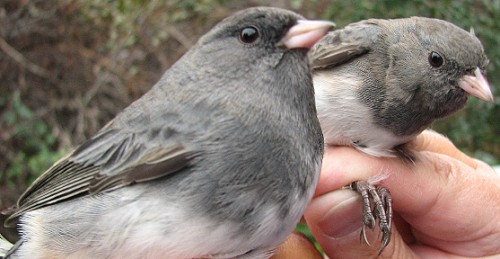 These two Slate-coloured Juncos really show off the differences in the sexes, the female at the rear and the male at the front. (Photo by Barbara Frei)
These two Slate-coloured Juncos really show off the differences in the sexes, the female at the rear and the male at the front. (Photo by Barbara Frei) What might be the final new species banded for the 2007 fall season, we were lucky enough to get two Northern Shrikes this past week: a second-year bird (based on some retained juvenile feathers in the wing) and a hatch year bird. Note the differences in the darkness of the facial mask, as well as the differences in the colour of the face (grey vs brown). (Photos by Marie-Anne Hudson and Greg Rand)
What might be the final new species banded for the 2007 fall season, we were lucky enough to get two Northern Shrikes this past week: a second-year bird (based on some retained juvenile feathers in the wing) and a hatch year bird. Note the differences in the darkness of the facial mask, as well as the differences in the colour of the face (grey vs brown). (Photos by Marie-Anne Hudson and Greg Rand)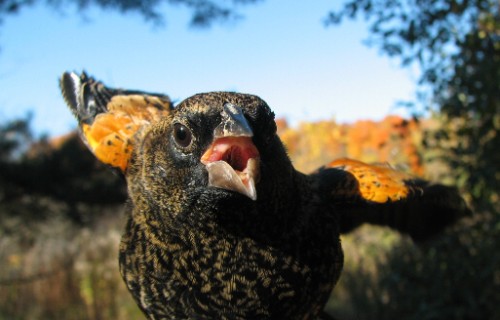 We were stoked to find this fine fellow in our nets this week, since we’ve only ever gotten one per fall season before! Granted we get our fill in spring, but in fall they tend to stay in the tree tops far above our nets. Interestingly, the only Red-winged Blackbird we banded in the fall of 2006 also came in week 12! (Photo by Barbara Frei)
We were stoked to find this fine fellow in our nets this week, since we’ve only ever gotten one per fall season before! Granted we get our fill in spring, but in fall they tend to stay in the tree tops far above our nets. Interestingly, the only Red-winged Blackbird we banded in the fall of 2006 also came in week 12! (Photo by Barbara Frei)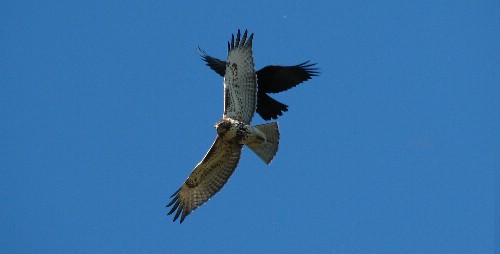 No, we didn’t band this Red-tailed Hawk, but we were quite impressed at its ability to dodge our curious American Crows! (Photo by Barbara Frei)
No, we didn’t band this Red-tailed Hawk, but we were quite impressed at its ability to dodge our curious American Crows! (Photo by Barbara Frei)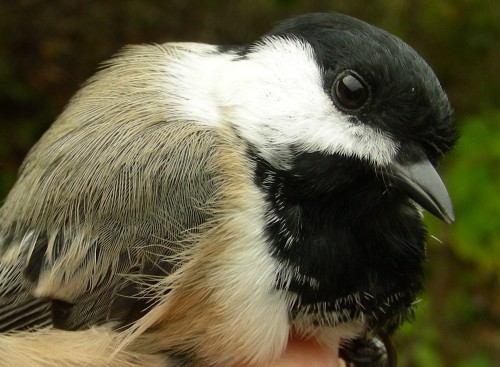 We were astounded to find this hatch-year Black-capped Chickadee in our nets (twice) this week – that in itself is of course quite common with chickadees, but this one had a massive growth on its neck! It must be a fast-growing tumour or abscess since it was initially banded just a week or two ago, with no signs of any growth. It was in fine form so we released it, wished it well, and hope to recap it again soon (minus the growth). There is growing evidence that Black-capped Chickadees may be vulnerable to environmental contaminants, as discussed in a recent
We were astounded to find this hatch-year Black-capped Chickadee in our nets (twice) this week – that in itself is of course quite common with chickadees, but this one had a massive growth on its neck! It must be a fast-growing tumour or abscess since it was initially banded just a week or two ago, with no signs of any growth. It was in fine form so we released it, wished it well, and hope to recap it again soon (minus the growth). There is growing evidence that Black-capped Chickadees may be vulnerable to environmental contaminants, as discussed in a recent 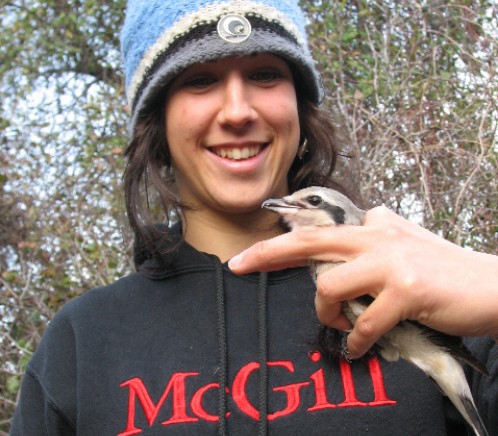 Katleen has the distinct honour of being the first person to have their photo as the picture of the week! Granted she has to share the stage with our final bird of the 2007 fall season, this feisty little hatch-year Northern Shrike, but we’re sure she doesn’t mind. It was a record year for this uncommon species, with three shrikes banded in the last two weeks of the season. (Photo by Barbara Frei)
Katleen has the distinct honour of being the first person to have their photo as the picture of the week! Granted she has to share the stage with our final bird of the 2007 fall season, this feisty little hatch-year Northern Shrike, but we’re sure she doesn’t mind. It was a record year for this uncommon species, with three shrikes banded in the last two weeks of the season. (Photo by Barbara Frei)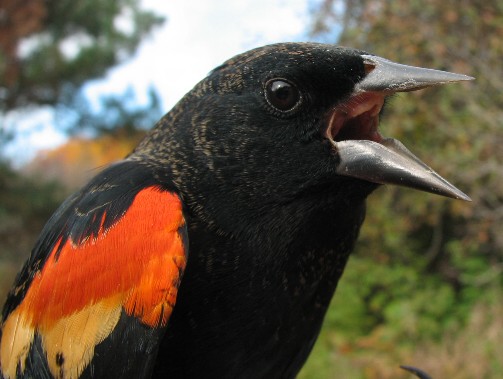 So much for just banding one Red-winged Blackbird per fall season! Not only did we break the fall shrike record with three banded, but the red-winged record with three as well! (Photo by Barbara Frei)
So much for just banding one Red-winged Blackbird per fall season! Not only did we break the fall shrike record with three banded, but the red-winged record with three as well! (Photo by Barbara Frei)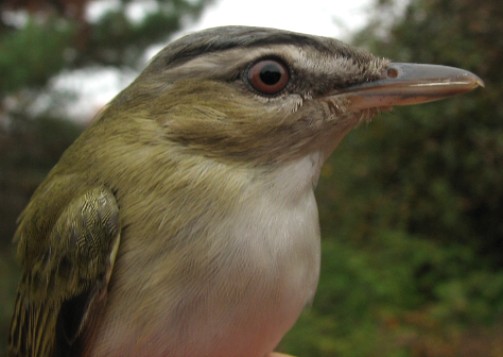 We were quite surprised to band this hatch-year Red-eyed Vireo last Wednesday (Oct 24), since we hadn’t seen one since October 11, and the last ones of the season were spotted on October 6 in 2005, and October 17 in 2006! (Photo by Barbara Frei)
We were quite surprised to band this hatch-year Red-eyed Vireo last Wednesday (Oct 24), since we hadn’t seen one since October 11, and the last ones of the season were spotted on October 6 in 2005, and October 17 in 2006! (Photo by Barbara Frei)